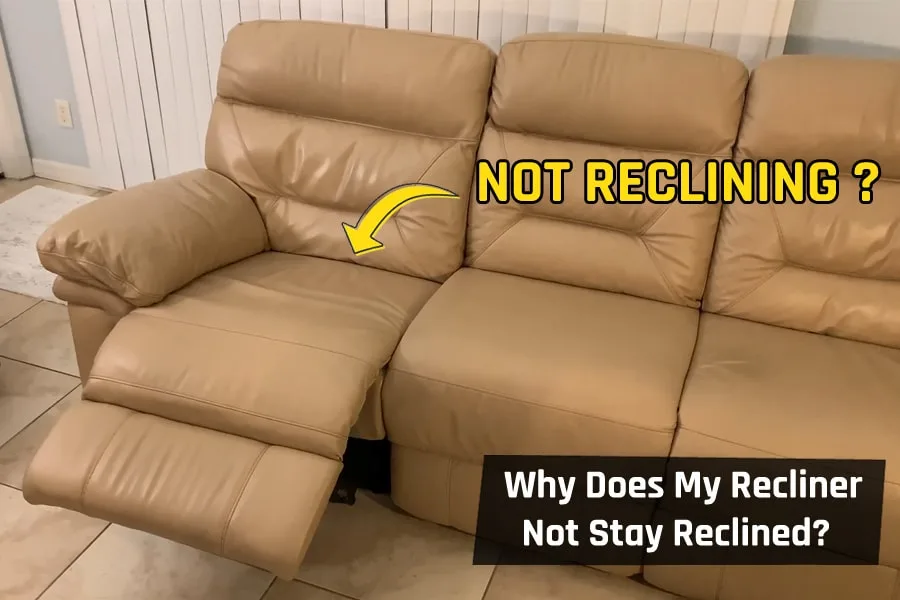A recliner may not stay reclined primarily due to issues with tension, damaged springs, loose mechanisms, assembly errors, or underlying mechanical problems.
This problem can make it feel as if the spring or strut has too much pressure, preventing it from remaining in the reclined position.
Incorrect tension or damaged springs can affect the reclining function, while loose mechanisms, assembly errors, or underlying mechanical issues can contribute to the inability of the recliner to maintain a reclined position.
Identifying and addressing these factors is essential to resolving the question of “Why Does My Recliner Not Stay Reclined?” and ensuring proper functionality.

Why Does My Recliner Not Stay Reclined – Detailed Discussion
Recliner tension determines the force needed to recline the chair. When this tension isn’t set correctly or is too low, the recliner back won’t lock in place or recline, possibly returning to an upright position too easily.
Concerns with Springs
Damaged or worn-out tension springs in the recliner can impede its ability to maintain a reclined position. In such cases, replacing these springs with new ones may be the solution.
Problems with the Recliner Mechanism
Examine the recliner for loose or damaged parts in the mechanism, as screws, bolts, or components can loosen or break over time, preventing the recliner from staying reclined. Tightening or replacing these parts can resolve the issue.
Assembly Errors
If the recliner was recently assembled or disassembled, incorrect reassembly may be the cause. Carefully follow assembly instructions, ensuring all components are correctly aligned and connected.
Mechanical Concerns
If no other causes are evident, underlying mechanical issues within the recliner mechanism may be at play. In such cases, consulting an expert or reaching out to the manufacturer for assistance is advisable.
How to Fix Recliner Not Stay Reclined
If you’ve explored the potential causes of a recliner’s failure to maintain a reclined position, you might be wondering about possible solutions.
The exact remedy can vary depending on the underlying issue, but the following steps can help you address the problem:
Fixation 01: Properly Adjusting Recliner Tension
Step 01: Evaluate the Current Tension
Begin by evaluating the current tension in your recliner. While seated, note how it feels when reclining. Is it overly rigid, making reclining difficult, or excessively loose, causing you to sink back too easily? This initial assessment will guide your adjustments.
Step 02: Identifying the Adjustment Mechanism
Inspect your recliner to locate the tension adjustment mechanism, typically situated beneath the seat or behind the backrest. Common adjustment types include knobs, levers, or sets of bolts.
Step 03: Gathering the Right Tools
Depending on the adjustment mechanism, you may require specific tools like a screwdriver, Allen wrench, or pliers. Ensure you have the appropriate tools ready before proceeding.
Step 04: Starting with Small Adjustments
It’s wise to commence with minor adjustments to avoid extremes. If the recliner feels overly tight, loosen the tension slightly; if it’s too loose, tighten it a bit. Make quarter-turn adjustments to gauge their impact on the reclining experience.
Step 05: Testing and Repeating
After each adjustment, test the recliner by reclining and ensuring it maintains the desired position.
Pay attention to how the tension feels and whether it provides the support and comfort you desire. If necessary, continue with small adjustments until you find the optimal tension.
Step 06: Fine-Tuning as Needed
If you’re close to achieving the desired tension but require slight adjustments, make half-turn or eighth-turn changes to fine-tune the tension. Always test the recliner after each adjustment to assess its effect.
Fixation 02: Replacing Tension Springs:
Step 01: Preparing for Replacement
Prior to beginning the replacement process, ensure you have all the necessary tools and components ready. You’ll typically require pliers, safety goggles, a screwdriver, and heavy-duty replacement springs.
When seeking replacement springs, make sure to obtain ones specifically designed for your recliner model.
Consult with a local recliner retailer or search online for reputable dealers offering compatible replacement parts, ideally following the manufacturer’s recommendations for optimal performance and durability.
Step 02: Flipping the Recliner Over
Gently tilt the recliner forward to access the frame beneath the seat, ensuring the footrest is down and the backrest is upright. Take care to prevent any damage to the upholstery or other recliner parts.
Step 03: Locating Attachment Points
Inspect both sides of the recliner for clips or tabs where the tension springs are attached. If the old springs are still in place, identify the points where they connect to the frame at each end of the spring.
Step 04: Removing the Old Springs
Use pliers to firmly grip one end of the spring and carefully detach it from the frame by pulling and twisting. Exercise caution, as the spring will be under tension, and wear protective safety goggles to shield your eyes from potential metal fragments.
Step 05: Stretching the Springs
Position a screwdriver along the loop on each side of the replacement spring. Gently pull the spring apart to stretch it, sliding a nickel or washer between each coil to separate them. This step ensures proper tensioning and functionality of the spring.
Step 06: Installing the New Springs
Attach one end of the replacement spring to the designated attachment point on the recliner frame.
Use pliers to secure the spring to the frame at the other end, taking extreme caution when handling springs under tension. Maintain a firm grip by using locking adjustable pliers.
Step 07: Removing Separators
Gently remove the nickels or washers that were placed between the coils of the replacement spring, allowing the spring to return to its normal tensioned state.
Step 08: Testing the Springs
Carefully flip the recliner back over and return it to an upright position. Sit in the chair and lean against the backrest to assess the tension of the newly installed springs.
When reclining, there should be noticeable resistance, providing the desired support and comfort. If the tension is not satisfactory, consider trying a different set of springs or making additional adjustments as needed.
Explore Additional Solutions
In addition to the previously mentioned solutions, consider trying the following measures to address common issues with recliners failing to stay reclined:
Inspect and Secure Screws and Bolts
Over time, the constant motion of a recliner can cause screws and bolts to come loose. If you’re experiencing issues with your recliner, such as an Ashley recliner not staying reclined, use a screwdriver or wrench to tighten all visible screws and bolts within the recliner mechanism.
Pay particular attention to the points where the reclining mechanism connects to the frame.
Lubricate the Recliner Mechanism
Inadequate lubrication can lead to friction and hinder the smooth operation of your recliner. Apply a lubricant designed for moving parts, such as silicone spray or furniture oil, to the joints and pivot points of the reclining mechanism.
Check the Recliner Cable
If your recliner utilizes a lever or handle to activate the reclining mechanism, inspect the cable connecting the lever to the recliner mechanism. This cable may become loose or damaged over time.
Examine it for signs of wear or fraying and replace it with a new one if necessary, following the manufacturer’s instructions.
Examine the Recliner’s Footrest Lock
Some recliners feature a footrest lock mechanism designed to keep the footrest in place when reclined. If you find that the footrest is not remaining in its intended position, inspect the lock mechanism for obstructions or damage.
Address any issues by cleaning, repairing, or seeking guidance from the manufacturer regarding adjustments or replacements.
Guidelines for Maintaining a Recliner in the Reclined Position
Choose the Right Recliner
When shopping for a recliner, focus on the quality and design of the reclining mechanism.
Opt for a well-known, reputable brand known for its durable and dependable recliners. Test the recliner in-store to ensure it maintains the desired reclined position before making your purchase.
Position the Recliner on a Flat Surface
Uneven surfaces can impact the performance of the reclining mechanism. Place your recliner on a flat, stable surface, ensuring that all four legs make even contact with the ground.
This provides a solid foundation, reducing the risk of the recliner slipping or losing its reclined position.
Avoid Excessive Weight on the Footrest
Overloading the footrest can strain the recliner mechanism and make it harder to stay reclined. Be mindful of the weight placed on the footrest, particularly when fully reclined. Avoid sitting or stepping on the footrest, as it can lead to damage over time.
Use the Recliner Gently
Operate the recliner with care, avoiding sudden or forceful movements. Treat the recliner gently and refrain from applying excessive pressure on the reclining mechanism.
Slowly recline and return the chair to an upright position to minimize stress on the mechanism.
Regularly Clean and Maintain the Recliner
Dust, dirt, and debris can accumulate in the recliner’s mechanism, affecting its performance. Routinely clean the recliner by vacuuming or wiping it down to remove any particles that could impede the smooth operation of the reclining mechanism.
Additionally, adhere to the manufacturer’s maintenance recommendations, including lubricating moving parts as advised.
Keep Children and Pets Away
Children or pets playing around or climbing on the recliner can exert additional stress on the reclining mechanism. To prevent potential damage or accidents, discourage them from using the recliner as a play area or climbing surface.
Follow Manufacturer’s Instructions
Each recliner is unique, and the manufacturer’s instructions serve as your primary guide for operating and maintaining your specific recliner model.
Familiarize yourself with the user manual and adhere to the provided guidelines for tension adjustments, cleaning, and overall maintenance.
FAQ
Can I replace tension springs to fix my recliner’s reclining issue?
Yes, you can replace tension springs to resolve your recliner’s reclining issue. Replacing damaged or worn-out tension springs is a common solution to ensure the recliner stays reclined as desired.
How can I identify loose mechanisms in my recliner that affect its reclining function?
To identify loose mechanisms in your recliner, examine the chair for wobbling or instability when reclining. Listen for unusual sounds, like rattling or clicking. Inspect for visible loose screws, bolts, or disconnected components within the reclining mechanism.
Last Notes
Addressing a recliner that refuses to remain reclined might prove exasperating. However, with some knowledge and maintenance, you can rejuvenate your beloved chair.
By comprehending common issues and applying solutions, uninterrupted reclining comfort can be yours. Accurate diagnosis, tightening mechanisms, repairing damage, tension adjustments, and lubrication are vital steps.
Routine preventive care also prolongs your recliner’s life, promising years of relaxation and comfort.
